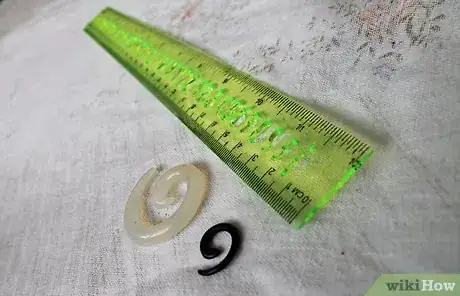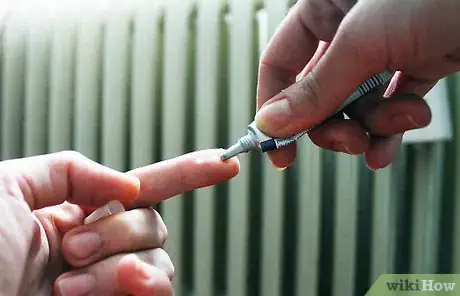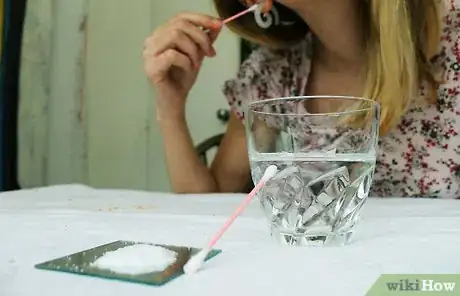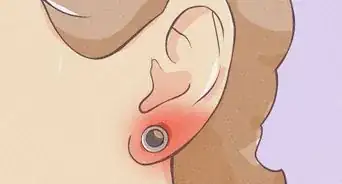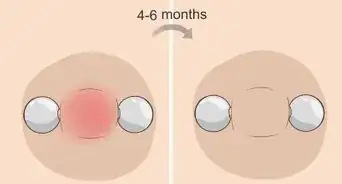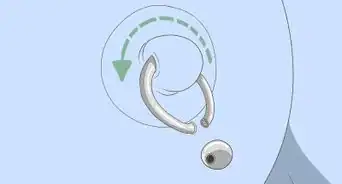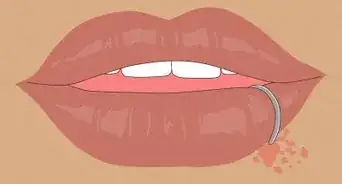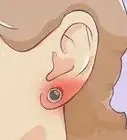X
wikiHow is a “wiki,” similar to Wikipedia, which means that many of our articles are co-written by multiple authors. To create this article, 45 people, some anonymous, worked to edit and improve it over time.
This article has been viewed 261,677 times.
Learn more...
Any piercing can be stretched to a larger size. How fast you can stretch depends on the body part, and your skin's elasticity. Jewelry sizes are measured in gauges, millimeters, and eventually inches. Gauges go down by even numbers; the higher the number, the smaller the jewelry (8g is next largest size after 10g.) After 00g, most jewelry is measured in inches or millimeters. (The next size after 00 is 7/16")
Steps
-
1Be sure you've washed your hands with antibacterial soap before touching the jewelry or the fistula (piercing hole)[1]
-
2Stretch one size at a time. Sizes go down in number, by two's (for example, 12g to 10g, etc). You will regret it if you do not as you will cause scar tissue and a blowout.Advertisement
-
3Use a water based lubricant or a specialized stretching oil. Do not use vaseline or anything else that will clog up the piercing and trap bacteria.(Do NOT use Neosporin!)[2]
-
4Never use acrylic/silicone/kaos/collapsible plugs or tunnels to stretch, they will irritate your piercing and more often than not tear your ear.[3]
-
5Use a taper to stretch the piercing.
-
6Soak the area with sea salt to draw out any possible infections.[4]
Advertisement
Community Q&A
-
QuestionI had a stud put in but its not a starter one. Is this okay?
 Community AnswerIt is fine, because it will keep the hole open. You should keep it in for a while to make sure it stays open.
Community AnswerIt is fine, because it will keep the hole open. You should keep it in for a while to make sure it stays open. -
QuestionMy stud is like enclosed in my nose. How do I stretch the hole open more to put my hoop back in?
 Community AnswerTwist the stud until it comes out, then clean out the piercing. If it closes up, you will have to get it repierced.
Community AnswerTwist the stud until it comes out, then clean out the piercing. If it closes up, you will have to get it repierced. -
QuestionI got my ears pierced with a gun 12 years ago and one more single piercing not in cartilage about 5 years ago. How I should I go about getting them to fit a 16 as that seems to be the most popular size?
 C12H22O11 HIGHCommunity AnswerUse stretching tape. It stretches the piercing safely and you won't have to buy tons of new jewelry.
C12H22O11 HIGHCommunity AnswerUse stretching tape. It stretches the piercing safely and you won't have to buy tons of new jewelry.
Advertisement
Warnings
- Weights are not a good idea to stretch your piercings, as it puts pressure on the bottom only, and can cause thinning. Weight earrings are for short periods of time, a few hours to half a day at most. Wearing heavier materials will help your holes loosen faster, but heavy weights are a bad idea.⧼thumbs_response⧽
- Blowouts are when the inside of the piercing, the fistula, is pushed outside, and forms a "lip". They happen from forcing a stretch before your piercing is ready, or skipping sizes. To heal a blowout, downsize and do oil massages. Insert your jewelry from the back to help push the fistula back in. Blowouts can permanently heal if not treated, and will need minor surgery to be removed.⧼thumbs_response⧽
- Scar tissue comes from damage while stretching. It makes future stretches harder, and looks bad. Do oil massages to reduce scar tissue, downsize if the scarring is severe. A piercing that looks very wrinkly (cat butt) is probably due to scar tissue.⧼thumbs_response⧽
- Piercing guns are unsafe, and traumatic, compared to needles. For the safest and most painless piercing, go to a professional piercer that you trust. Make sure they use new needles, or autoclave all their materials.⧼thumbs_response⧽
- Stretching should be considered permanent. There is a good chance that a piercing will shrink after stretching, but no guarantee. Don't stretch if you aren't willing to stay at that size. Stretching past 2g (6mm) is usually considered the "point of no return", but for some it's smaller, for others larger.⧼thumbs_response⧽
- Stretching too fast, or skipping gauges can cause your skin to tear. If your stretch is bleeding, or has lymph fluid which makes a crust, downsize your jewelry to a smaller gauge, and use saline solution to clean it with. Make a weak solution of sea salt and hot water, and soak your piercing for 5-10 minutes. Rinse your skin with clean water afterward. Do this at least daily until it's healed. Too much salt can cause more harm than good, the solution should taste like tears.⧼thumbs_response⧽
- Cartilage piercings should not be stretched using the above steps. Larger cartilage piercings, such as an inner conch, are generally pierced at the desired gauge. Stretching may result in the formation of keloids.[5]⧼thumbs_response⧽
Advertisement
Things You'll Need
- Body jewelry one size larger than your current jewelry.
- A taper or PTFE tape
- Lubricant, preferably vitamin E, emu, or jojoba oil.
- Patience
References
- ↑ https://www.arka-shop.co.uk/acatalog/ear-stretching-kits.html
- ↑ https://www.arka-shop.co.uk/acatalog/ear-stretching-kits.html
- ↑ https://www.precisionbodyarts.com/stretching-a-piercing
- ↑ https://www.bluebanana.com/piercing.php/473/ear-stretching-how-to-stretch-your-ears-piercing-information-uk
- ↑ http://en.wikipedia.org/wiki/Stretching_%28body_piercing%29#Health_issues
About This Article
Advertisement

